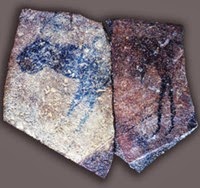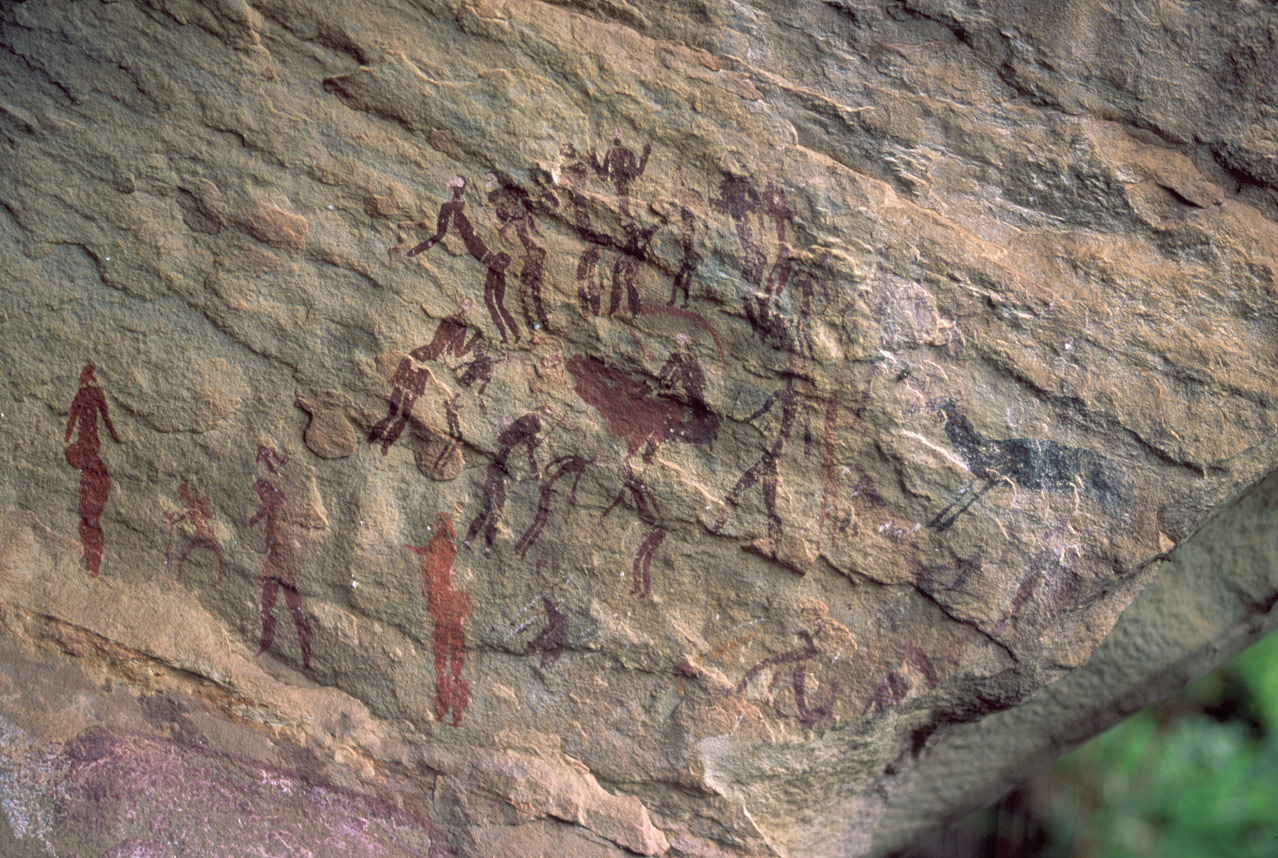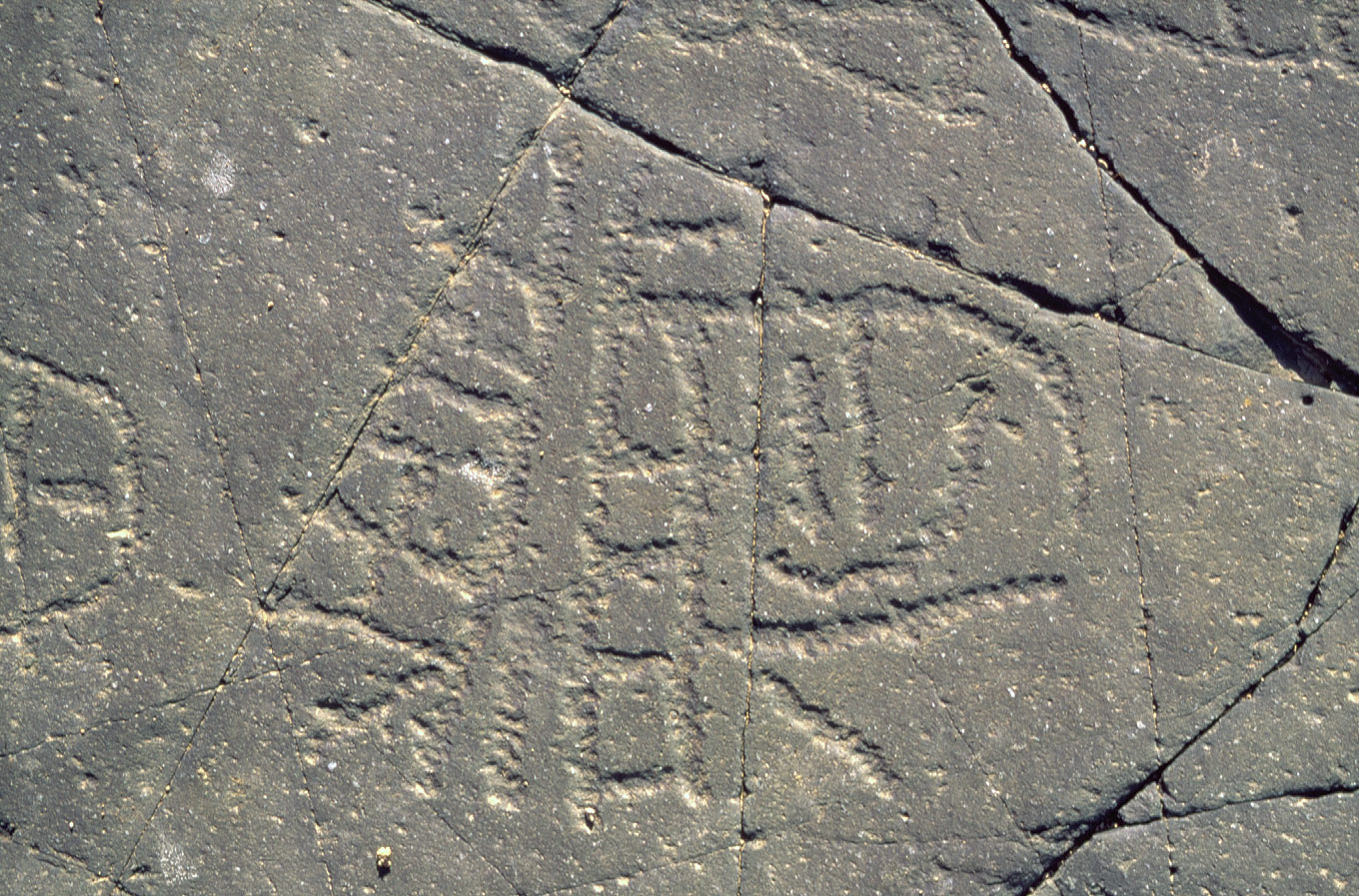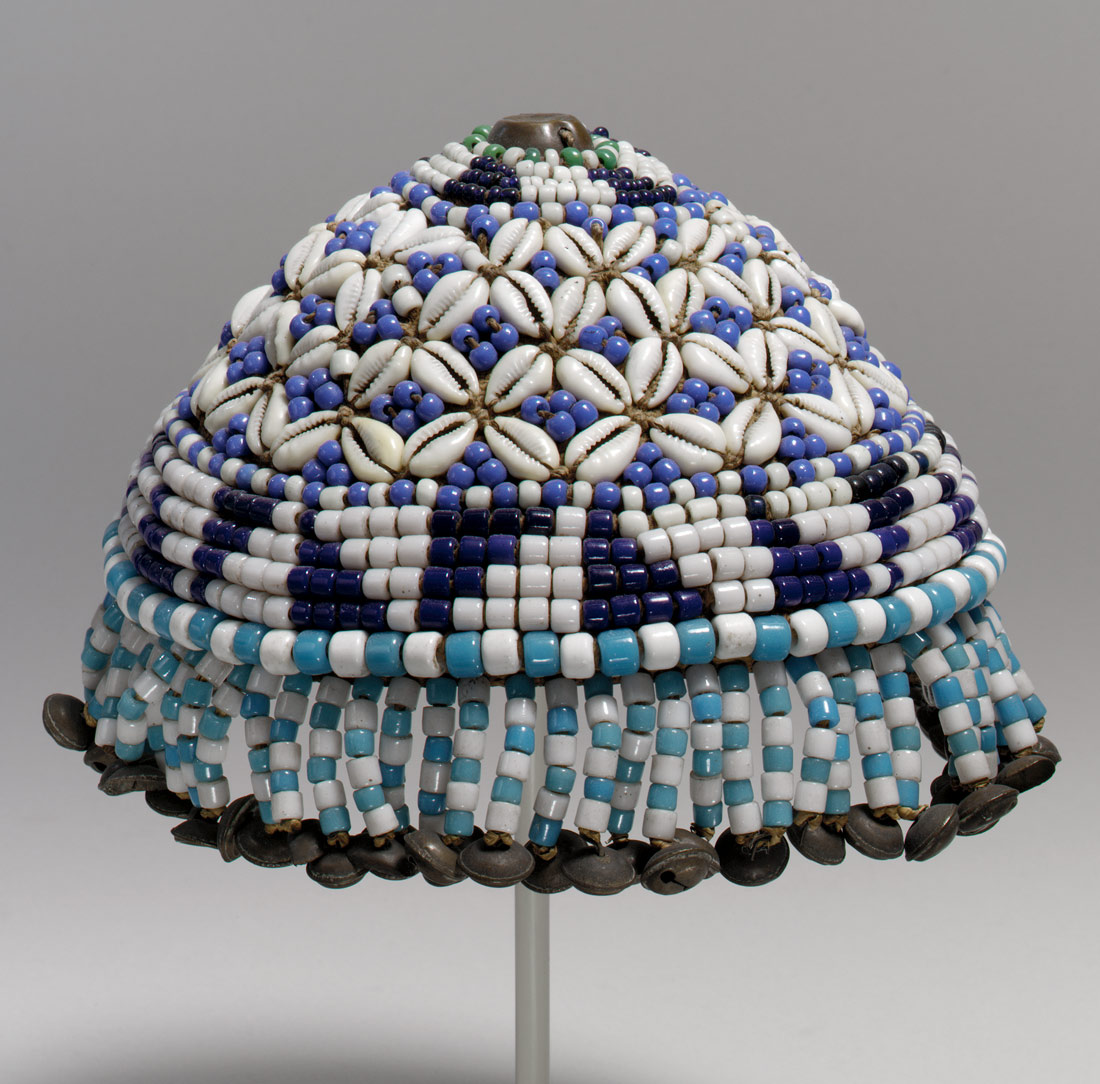Ancient African Art (~25,000BC- ~300AD)
Archaeologists discovered some of the oldest signs of art in Southern Africa. Rock paintings have survived centuries, protected in caves and with arid climates. The Apollo 11 rock paintings are the most accurately dated ancient African art. They were created thousands of years ago, around 25,500 BC. Some rocks were buried, leading historians to muse about possible religious significance or connection to the afterlife. The rock paintings show crude depictions of different animals indigenous to the regions as well as abstract designs that may have been of religious or cultural significance. The artists used charcoal, ocher, and white coloring. It is the charcoal that allows archeologists to so accurately date the paintings using carbon-dating techniques. Two of the Apollo 11 cave stones are pictured here:
Rock and cave paintings continued to dominate the ancient African artistic scene for centuries. The artists were part of hunter/gatherer societies who both relied on and feared the land. These societies are often described as pagan, because they worshipped deities inherently connected to the Earth such as rain or animal gods. While paintings are assumed to have been done using fingers, there is evidence of engravings as well using sharpened stones. Most of these ancient artifacts were located in South Africa. Over time, the paintings improved to show recognizable humanoid figures. Some engraved symbols may have even been a form of rudimentary language. Examples of a rock painting and engraving are shown from the MET website.


About 500 years before the Common Era, African art moved on from two-dimensional to three-dimensional in the form of statues. The Nok people Terracotta Statues found in Northwest Africa are a famous example of the oldest African figurative sculpture, and some of the oldest sculpture in world history. The Nok people came into existence in around 800-500 BC. They were an incredibly advanced society, with a complex judicial system, division of labor, and focus on technological development and the arts. The Nok people sculpted terracotta statues, emphasizing heads that have been commonly described as “alien” in appearance. Historians are not sure what lead to the Nok people’s disappearance in approximately 200 AD, but there statues have survived. They were sculpted subtractively, meaning the figure was made by carving out empty space instead of building clay up and shaping it. Historians speculate that the sculptures may have had religious significance, or been used to commemorate leaders. What are your thoughts on these strange statues?

African Art of the Middle Centuries (~12th-~20th century A.D.)
The middle centuries were a time of great change in Africa. Society quickly advanced into a form we would recognize as civilization. Artists began experimenting with new techniques, and increased global trade brought influences from other parts of the world. In around the 12th century, West Africa, the Yoruba people of the city of Ife were creating sculptures with metal. Again, they focused on heads, sculpting what were likely portraits of rulers. They focused on Oonis, or kings, who would commission sculptures made of a coppor alloy. The metal heads have patterned holes and stripes in them, perhaps indicative of traditional face painting, piercings, or tattoos. The heads have been incredibly well-preserved due to their metal nature. They were found buried underground by residential developers and quickly swept away to be studied and placed in secure museums. The heads show less grotesque figures, instead giving reasonable proportions to their subjects. Here is a Yoruba head dated to the 14th century.
Jumping ahead to the 17th-18th centuries in Central Africa, we see the Kuba Kingdom art. At this point, Central Africa had been revolutionized by global trade. There were plentiful natural resources and political stability conducive to investments in the visual arts. The Kuba Kings were famous for commissioning elaborate costumes and artwork. Kuba artists used mainly beads, palm fiber, and wood to make sculptures, clothing, and textiles. Palm products were especially available in the area, so cloth was made using the fiber in its leaves its oil was used in sculpting. Below, we see a Laket Mishiing or “titleholder’s hat” worn by someone with political power, and a wooden statue of Kuba King Shyaam aMbul a Ngoong.


The last major art form we will touch on are the Kongo (Congo) Ivories, manufactured in the Lower Congo Region of Africa in the 18th-20th centuries. Ivory was a valued natural resource in the region, and had been used within Africa for royal artifacts such as scepters and statues. Western explorers who occupied the Congo at the time of Belgian King Leopold’s rule brought a seemingly insatiable demand for ivory. The trade for elephant tusks experienced huge growth, at the cost of many elephants’ lives. The ivory was used to sculpt humanoid figures and scenes of cultural importance. It was also made into pretty gifts for foreign ambassadors to attract further trade. Ivory royal scepters were of particular importance within the indigenous African culture, as they were used for religious and political purposes by people in positions of power. An ivory royal scepter of an African male is pictured here:

Many examples of mid-century African art is on display in my hometown of Cleveland, Ohio. If you ever get the chance to visit, take some time to explore our wonderful art museum. Here are some highlights from the Cleveland traditional African art collection:
Modern African Art (1900s-today)
Africa is an integral part of the modern world. Globalization and foreign occupation have greatly contributed to modern African art. Some artists work with European influences mixed with African culture, while modern day traditionalists use materials similar to the artists of their ancestors. There are many different styles, mediums, and artistic philosophies in modern day Africa. Here we will highlight a few well-known African artists with different styles. Tracey Rose is a South African artist with strong feminist ideals. Her photographs and paintings focus on stereotypes imposed on African men and women, and the strength of woman and her sexuality. As a mixed-race South African, she also looks at racial identity. Her work is often described as abstract or surrealist. She is also known as a performance artist. Here is her Lucie’s Fur Version 1:1:1 – I’ Annunciazione (After Fra Angelico)
Kudzanai Chiurai is from Zimbabwe. He is known for using photorealistic techniques to express political themes and comment on social issues. His preferred medium is ink or pencil on paper. It is incredible to see how much like a photograph his drawings appear. Here is his Revelations I

Julie Mehretu is from Ethiopia, although currently located in NYC, United States. She is a modernist, using abstract techniques to create very urban art. Her works are often mixed-media and use layers to create abstraction. Her work has been displayed at the Museum of Modern Art. Here is Mehretu’s Retopistics: A Renegade Excavation

Ibrahim El Salahi is the Sudanese “godfather of modernism.” He grew up in a time of political turmoil, which influenced his abstract and surrealistic drawings and paintings. He prefers muted colors, especially black and white. Here is his Self-Portrait of Suffering

Citations:https://www.metmuseum.org/toah/hd/sroc/hd_sroc.htm
http://www.visual-arts-cork.com/prehistoric/apollo-11-cave-stones.htm
http://www.metmuseum.org/toah/hd/nok/hd_nok.htm
http://www.goodman-gallery.com/files/upload/inventory/17934Inventory22562-1020_preview.jpg
http://www.goodman-gallery.com/files/upload/inventory/24709Inventory18447-1020_preview.jpg
http://blogs.artinfo.com/modernartnotes/files/2013/05/MehretuRetopisticsARenegadeExcavation2001.jpg
http://images.tate.org.uk/sites/default/files/styles/grid-normal-12-cols/public/images/013-post_slade_21_-_00229_ns-2_0.jpg?itok=O4uHgwCp
http://www.clevelandart.org/art/departments/african-art
https://upload.wikimedia.org/wikipedia/commons/1/1d/Yoruba-bronze-head.jpg
https://www.metmuseum.org/toah/hi/te_index.asp?i=Africa